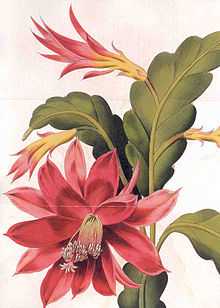Disocactus ackermannii
| Disocactus ackermannii | |
|---|---|
 | |
| From Curtis's Botanical Register, 1830 | |
| Scientific classification | |
| Kingdom: | Plantae |
| (unranked): | Angiosperms |
| (unranked): | Eudicots |
| (unranked): | Core eudicots |
| Order: | Caryophyllales |
| Family: | Cactaceae |
| Subfamily: | Cactoideae |
| Tribe: | Hylocereeae |
| Genus: | Disocactus |
| Species: | D. ackermannii |
| Binomial name | |
| Disocactus ackermannii (Haw.) Barthlott[1] | |
Disocactus ackermannii is an epiphytic cactus from tropical forests in the states of Veracruz and Oaxaca, Mexico. In cultivation, it has been confused with Disocactus ×hybridus, a hybrid between D. phyllanthoides and D. speciosus.
Description
The stems of Disocactus ackermannii consist of a short rounded base, about 10–18 cm (4–7 in) long, followed by longer flattened leaf-like portions, 10–75 cm (4–30 in) long and 5–7 cm (2–3 in) wide with wavy edges. The plant branches from the base and arches downwards, being altogether some 1 m (3 ft) long. The scarlet flowers have greenish throats and are funnel shaped, 11–14 cm (4.3–5.5 in) long. Fertilized flowers are followed by green to brownish red fruits, 4 cm (1.6 in) long and 2–2.5 cm (0.8–1.0 in) wide.[1]
Taxonomy
The species was originally named Epiphyllum ackermannii by Adrian Hardy Haworth in 1829. There are three sets of synonyms:[1]
- Haworth's Epiphyllum ackermannii was successively transferred to Cactus ackermannii (1830), Cereus ackermannii (1837), Phyllocactus ackermannii (1842) and Nopalxochia ackermannii (1935) before the current Disocactus ackermannii (1991).
- Phyllocactus weingartii A.Berger is an independent synonym.
- Nopalxochia conzattianum was named by Thomas Baillie MacDougall in 1947. It was successively transferred to Pseudonopalxochia conzattianum (1959) and Nopalxochia ackermannii var. conzattianum (1981) before the current Disocactus ackermannii var. conzattianum (1991).
Two varieties are currently recognized. D. a. var. ackermannii has longer cladodes (flattened stem portions), 35–75 cm (14–30 in) long, and longer tepals, 7–10 cm (3–4 in) long. D. a. var. conzattianum has shorter cladodes, 10–50 cm (4–20 in) long, and shorter tepals, 4–6 cm (1.6–2.4 in) long.[1]
In cultivation, Disocactus ×hybridus, a hybrid between D. phyllanthoides and D. speciosus, has been confused with D. ackermannii and is often distributed under the name "Phyllocactus ackermannii".[2]